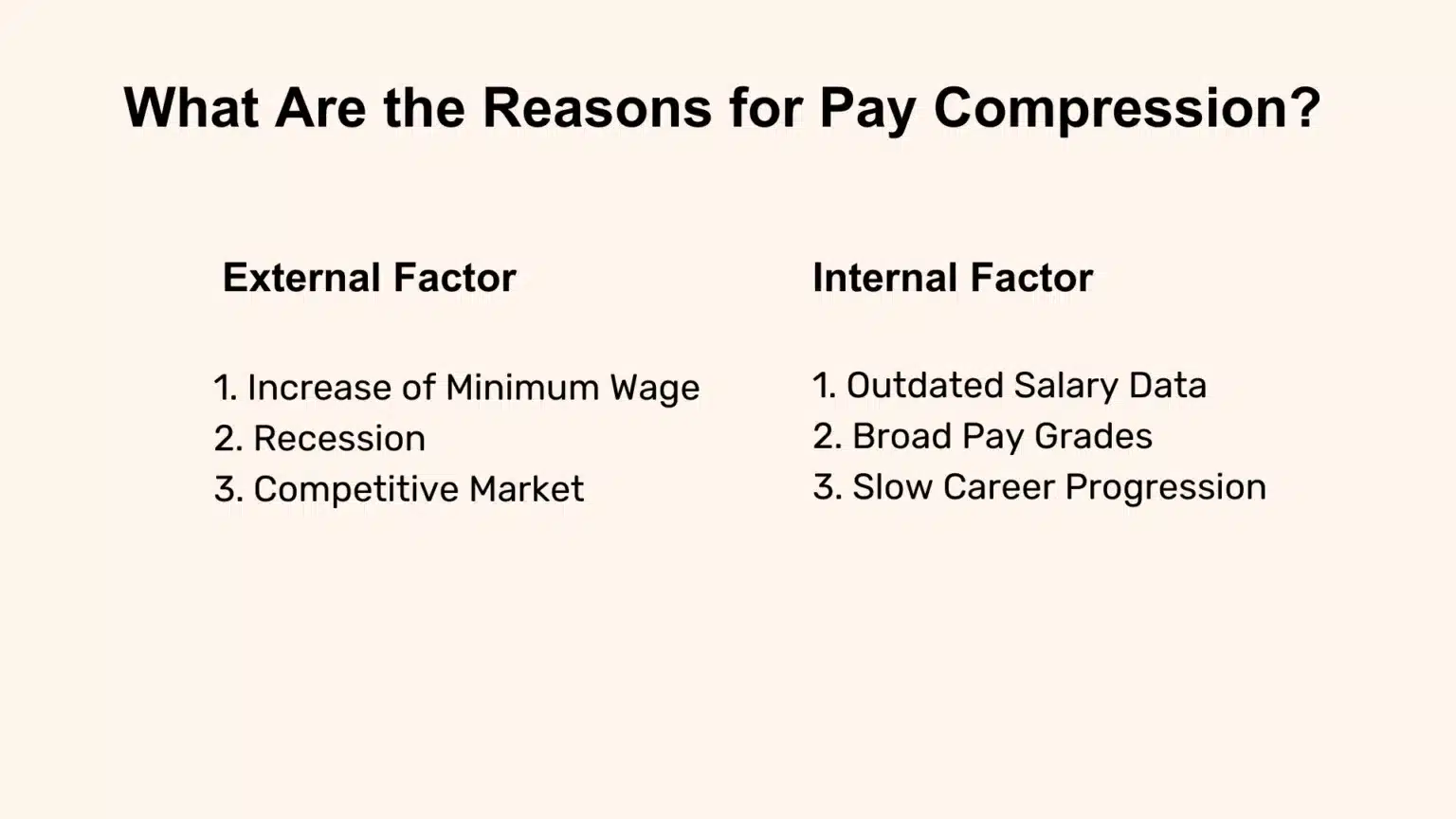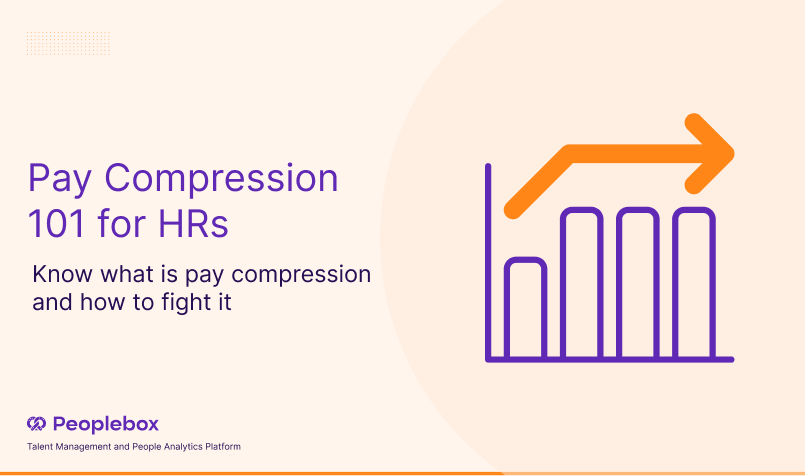You work hard to make sure employees feel valued.
Yet, the salary gap between employees with different experience levels and responsibilities is narrowing.
This is a major problem.
If not fixed, wage compression can cause:
- Employee dissatisfaction
- Low morale and productivity
- High turnover
- Legal scrutiny
Solution? A strategic approach to managing wage compression.
Read on for a comprehensive guide on pay compression.
We cover:
- What exactly is pay compression and why is it caused
- Understand why it’s important to fix wage compression and how to do so
- Learn how a people analytics software like Peoplebox can help
What is pay compression?
Pay compression occurs when there is a minimal difference in pay between employees regardless of their skills, experience, or seniority.
It means that the salary gap between the following is narrower than what is typically expected:
- Junior vs. senior positions
- New hires vs. long-term employees

What Are the Reasons for Pay Compression?

Pay compression is caused by two types of factors – external and internal.
External Factors
External factors refer to influences outside the organisation that affect salary structures. These include things like changes in minimum wage, recession, and a competitive job market.
1. Increase of Minimum Wage
When companies respond to an increase in minimum wages set by the state or national governments, the pay for entry-level positions goes up.
However, if the pay for other roles is not adjusted accordingly, the pay gap between entry-level jobs and higher-level roles can shrink.
It causes issues because the pay gap now does not accurately reflect the difference in their skill levels.
2. Recession
People hired during a recession usually start at lower salaries due to budget cuts.
When the market recovers, new hires are brought in at higher salaries.
Without adjusting the salaries of those hired during the recession, these employees end up earning less than the new hires despite having more experience.
3. Competitive Market
A competitive job market often means companies have to raise salaries to attract new talent, especially in high-demand industries.
This can lead to wage compression because the starting salaries for new hires increase compared to the salaries of current employees who were hired earlier at lower rates.

Internal Factors
Internal factors are related to a company’s own policies and practices, like using outdated salary data and having broad pay grades.
1. Outdated Salary Data
Outdated salary data can lead to unfair pay.
When pay scales aren’t updated regularly, long-term employees’ wages fall behind the market rates, while new hires are paid current market wages.
To ensure fairness, internal pay scales must be updated as the market changes, including adjustments for:
- Minimum wage increases
- Economic shifts like recessions or inflation
- A competitive job market
2. Broad Pay Grades
Poorly structured or broad pay scales can cause confusion about wages between different levels of seniority.
For example, if you have Level 1, Level 2, and Level 3 Engineers but only one salary range for all of them, it’s hard to see the differences between the roles.
This lack of differentiation between roles that require different skills and responsibilities can lead to wage compression.
3. Slow Career Progression
In organisations where career advancement is slow or promotions are rare, employees can end up with similar salaries despite differences in tenure, experience, or responsibility.
Let’s now look at the negative impacts of pay compression.
What are the Negative Impacts of Wage Compression?
Wage compression can negatively impact your organisation in key ways:
1. Reduced Employee Morale and Productivity
When wage compression happens, employees may feel that their experience and time with the company are undervalued.
This can lead to dissatisfaction and less motivation.
This is especially true for long-term employees who see new hires getting similar or higher pay rates.
2. Increased Turnover Rates
As employees become frustrated with the lack of significant pay differences between roles and tenures, turnover can increase.
Current employees, especially those in mid-level or senior positions, may seek opportunities with better pay differentiation elsewhere.
This leads to:
- Loss of institutional knowledge and experience
- Costs of recruiting new employees
- Cost of training new employees
3. Legal Risks
Wage compression may unintentionally result in pay disparities among employees with different protected characteristics:
- Age
- Gender
- Race, etc
This can expose the organisation to legal risks for potential discrimination or non-compliance with pay equity laws.
Now you know the negative impacts, let’s see if addressing it is really worth it.
What Is the ROI of Addressing Pay Compression?
You may be wondering why fixing pay compression seems expensive.
It can appear to lead to unsustainable payroll expenses as you attempt to correct imbalances.
However, the upfront cost of fixing pay inequities is often far less than the long-term costs of:
- Losing your valuable employees to the competition
- Recruiting, hiring, and training new employees
As evidence, 80% of organisations in the UK increased pay in 2023, with around half of these increases matching or exceeding the rate of inflation.
This statistic demonstrates that many companies recognise the importance of proactively tackling wage compression.
There are some key actions you can take.
Steps to Resolve Pay Compression
1. Align Your Pay With Market Rates
Make sure your salaries are competitive with the market.
Your approach may be to:
- Match the average market rates
- Pay higher than the market average
- Pay slightly lower than the average
Which approach you choose will be dependent on factors like:
- Your business objectives
- Size
- Location
- Financial goals
- Competitors
- Current state of the market
2. Identify Your Compensation Drivers
Apart from market rates, you should also know what other elements impact compensation in your organisation, also called compensation drivers.
According to Mercer, compensation drivers that influence where a job is positioned in a pay structure (i.e., grade or range) include:
- Pay grade
- Job characteristics (responsibilities, skill sets, educational requirements, etc)
- Work location
Compensation drivers that influence where an employee is positioned within a pay range include:
- Experience
- Performance
3. Establish Clear Career Pathways
Make sure employees understand how they can move up in the company.
This includes outlining:
- What they need to do to get to the next level
- How their pay will go up when they reach a new level
It helps motivate employees and clarifies expectations.
4. Improve Transparency and Employee Communication
Share with managers and employees how salaries are determined across the organisation.
Show that the leaders are working hard to fix any unfair pay issues.
This can improve employee morale and get their support in making needed changes to the pay structures.
5. Proactively Update Compensation Yearly
While it might be tempting to fix wage compression issues when they are brought up by the employees themselves, experts advise otherwise: “Resist the urge to address one-offs because there’s usually a ripple effect.”
Instead, make it a habit to review and adjust salaries across the whole organisation every year.
Proactively and regularly updating compensation company-wide offers several key benefits:
- Increases in pay are fair and not just for those who speak up or negotiate well.
- Deviations from established policies are quickly identified and corrected, maintaining long-term equity and fairness.
- By planning for these adjustments in your yearly budget, the cost of adjusting pay doesn’t come as a shock.
Now let’s look at how to actually make the salary adjustments across the company.

How to Update Compensation Company-wide
1. Conduct Internal Salary Audit
To conduct a thorough internal salary audit, start by gathering detailed data on current salary distributions to identify where wage compression is occurring.
This involves aggregating and analysing compensation data from various sources within the company, including base salaries, bonuses, and other types of pay.
Next, check and compare the salary data for recently hired employees versus longer-tenured employees across different roles and levels of experience.
By examining this data, you can notice discrepancies and patterns that indicate wage compression.
2. Benchmarking and Market Analysis
The next step is to conduct thorough benchmarking and market analysis. Start by comparing your company’s pay scales with industry standards. During this comparison, focus on evaluating where long-term employees are not compensated fairly relative to current market rates.
3. Calculate the Financial Impact
Now that you know if and where wage compression is occurring, you need to calculate the financial impact of fixing it. Start by finding the projected costs of various compensation adjustments. Then, decide on the adjustments that reduce wage compression the most while staying within your overall budget.
4. Get Leadership Buy-In
The next step is to get leadership buy-in for your chosen adjustments. Develop a detailed plan that outlines the timing, financial impact, and communication strategy for these changes. Present this plan to leadership to gain their approval.
5. Measure Employee Retention and Satisfaction
After getting approval and making the changes, it is important to track and measure the results. Use employee surveys and data to check whether the pay adjustments have impacted turnover rates and employee morale.
Track and share the positive effects with leadership to gain support for reviewing and fixing wage compression every year.
Conclusion
Proactively managing pay compression is essential to ensure that employees feel valued and motivated, which in turn supports organisational stability and growth.








